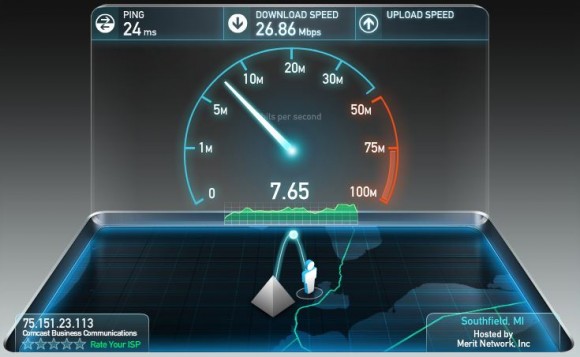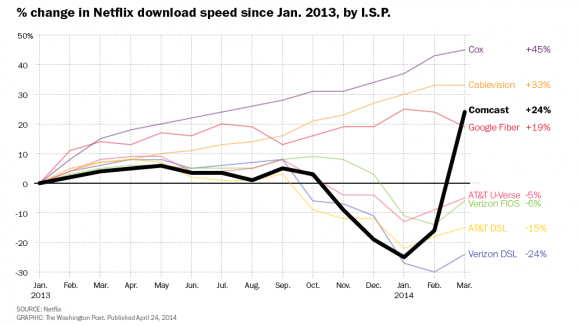Know your Bandwidth! Know your Rights!
Bandwidth and internet infrastructure is the driving force of the Information Age. Adequate bandwidth allows you to perform searches and find information at nearly the same speed as your fingertips on the keyboard. Insufficient bandwidth can turn a potential calm “movie night” into pure frustration and a dreadful series of agonizing lag or poor quality images.
We all rely on bandwidth in some way, and that reliance will only grow stronger in the coming years. Having some knowledge of bandwidth will provide you with a better understanding of your current internet service, your consumer rights, and expectations for the future.
What exactly is bandwidth?
Most of us that are familiar with internet service providers (ISP’s) and mobile phones are also acquainted with the term “bandwidth.” However, even today, this is one of the most commonly misunderstood concepts by those who rely on technology – and there’s an understandable reason for that. Depending on the context and technology being referenced, “bandwidth” can be used to describe a capacity, level of consumption, or an amount of data transferred over a period of time. To help ease some of the confusion, let’s take a look at how bandwidth typically applies to your network and ISP.
When you are using internet at home or the work place, the term “bandwidth” is likely referring to the “maximum throughput.” In other words, how much data can your connection or network transfer at a specific time? You’ll commonly see two specific measurements that answer this question: Download and upload speed. The download speed is generally what internet users are referring to when they talk about “internet speed” in casual conversation, because this measures the amount of data transferred IN to your network. The process of downloading is associated with the most common internet tasks, such as pulling up a website after a Google search or watching a movie on Netflix. As you may expect, the upload speed corresponds with data that you are transferring OUT to other networks; for example, when you upload a picture or video to Facebook.
How can I measure my ISP’s bandwidth?
Think about how many times each day you attempt to view website pages, send emails, or even load online videos – these actions all require the process of downloading. For this reason, your ISP will almost invariably provide more available bandwidth for tasks that necessitate downloading. In fact, when your ISP’s marketing refers to their “fast speeds” and they advertise a specific level of performance – say 50 Mb/s, for example – they are also talking about the download speed.
Emphasis is often placed on a network’s download capabilities, but you can easily measure both your download and upload speeds using a bandwidth testing tool. One of the most popular, free tools available is Ookla’s Speed Test. This tool’s accuracy is often praised by internet aficionados, and it can give you quick and valuable insight about the status and capabilities of your ISP.
In some instances, it may be helpful to run through multiple speed tests to determine if something about your connection has changed. For example, let’s say you’ve noticed that your internet speed seems to be lagging. Maybe your previous tests have shown a reasonable download speed somewhere between 10-20 Mb/s, but on this particular occasion, the download speed reported is less than 1 Mb/s. These results often signify a sudden throughput constraint. You can first try resetting your connection by powering both your modem and router off and then on again. If your speed does not significantly improve within the next couple minutes, it may be time to contact your ISP for further investigation and assistance.

ISP Bandwidth is about to become a bigger deal
Understanding bandwidth and how it relates to your home and business internet service is becoming more important each day. Increasing internet dependence and consumer demand for heavy bandwidth activities, such as video streaming services, should (in theory) encourage ISP’s to always work towards making data transfer faster. However, technology trends suggest that several industries will need even faster bandwidth sooner rather than later.
A recent investigation by Crain’s Detroit Business showed that the financial industry is especially likely to require faster speeds for large volumes of data transfer, security, and communication. For example, Credit Union One recently needed to nearly double their bandwidth so they could regularly replicate large quantities of data as part of their ongoing security protocols. They also plan to implement live video sessions as an option for their clients to engage with loan officers and other employees, which will soon necessitate an even greater bandwidth capacity.
Do you know your internet consumer rights?
Consumers have been creating a lot of buzz about “Net Neutrality” and their rights to equal, unrestricted bandwidth via the nation’s largest ISP companies. Within the past couple years, Comcast, AT&T, and other ISP giants have been intentionally throttling bandwidth and slowing the download process for specific companies and their services. For example, Netflix streaming services require high volumes of data to be continuously transferred to users, and ISP’s were demanding that Netflix pay them to ensure smoother streaming to their clients. Netflix agreed to start paying Comcast in early 2013, but did not work out an agreement with other popular ISP’s, such as AT&T and Verizon. You can see from this graph that the immediate change in Netflix download speed to Comcast clients was quite significant:

ISP’s argue that throttling bandwidth to certain services (such as Netflix) is essentially a necessary evil to maintain a balanced infrastructure for all their clients’ benefit. However, in February of this year, the FCC passed new rules that forbid ISP’s from intentionally slowing traffic, arguing that such behavior stifles innovation and oppresses consumers’ freedoms. Advocates of the FCC’s new Net Neutrality rules are encouraging consumers to hold ISP’s accountable by regularly running speed tests. The results of these tests are used to build a profile on each ISP, which tracks bandwidth metrics and suspicious changes in internet performance. ISP’s that show signs of illegal throttling practices may be reported to the FCC for further action. You can start running through the Internet Health Test tool – created by the consumer advocate group, “Battle for the Net” – and also contribute to the cause.
Sources:
http://www.crainsdetroit.com/article/20150515/BLOG122/150519900/financial-institutions-need-faster-bandwidth-for-security-business
http://mic.com/articles/88457/one-graph-shows-exactly-why-we-need-net-neutrality
http://www.nationaljournal.com/tech/2015/02/04/FCC-Chief-Unveils-Sweeping-Net-Neutrality-Rules


.png)
